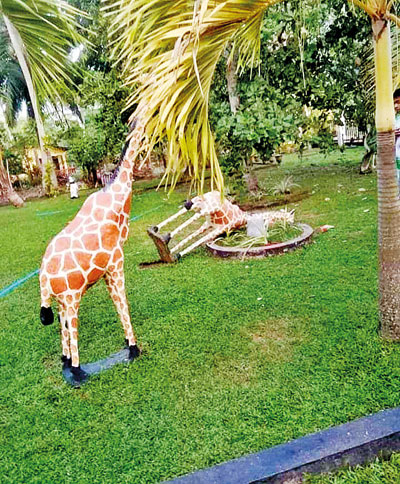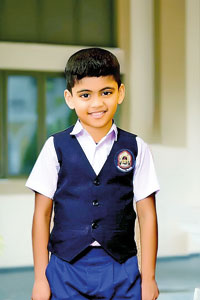News
How safe are your homes and surroundings for your children?
View(s):- Experts insist on making home environment childproof; share tips on preventing accidents
By Sandun Jayawardana
Health experts and police are urging parents and guardians to exercise more vigilance over their children at home following a rise in fatal accidents that have claimed the lives of several children over the past few weeks.
In one incident, an 8-year-old boy at Hettipola in Panduwasnuwara was killed when a concrete statue of a giraffe that was in the garden of his home fell onto him. The victim had tried to climb onto the heavy statue while playing outside by himself when it toppled over onto him.

Paediatrics Professor Ruwanthi Perera: Accidental injuries are a main cause of death and hospital admissions among children
Meanwhile, a 9-year-old child drowned after falling into an unprotected well in Gampola. He had been playing outside the house when his parents were not present. After coming home and not seeing the child nearby, his mother searched for him and found his body floating in the unprotected well near the home. He was admitted to the Gampola Base Hospital but was declared dead on admission.
At Aralaganwila in Polonnaruwa, a tragic accident claimed the life of a 3-year-old girl. In this incident, a large water tank at her house fell on her as she was bathing.
The vast majority of such accidents can be avoided, health experts and police noted.
In most cases, it’s negligence on the part of adults,” commented Police Spokesman Deputy Inspector General (DIG) Nihal Thalduwa. For example, he said police have seen children tragically drown in unprotected wells time and again. “We have seen unprotected wells in houses where small children live where the adults have not even made the slightest effort to ensure safety. Some places have large trees. The least they can do is cut some branches and make a makeshift barrier or fence to prevent children from getting near, but even such things are not done.”
Given the risk of serious injury to children due to “completely avoidable accidents” at home, parents should try to keep their children within sight whenever possible in the home environment, said the National Hospital’s Training Coordinator, Pushpa Ramyani de Zoysa. Trees that could fall over, statues and TV stands can all cause death or serious injury, she said.
Ms. Zoysa added that it is essential that adults take steps to ensure that their home is a safe place for children by keeping an eye out for danger and taking steps to childproof the home environment.
“For example, if a wall is cracked or leaning, you know there is a serious risk of collapse, and you should take steps to remedy that. The same can be said for trees that you notice are at risk of falling. Unfortunately, people don’t pay attention to even the most basic things. We have seen so many injuries from children trying to climb and hang onto things such as television stands. Sometimes, an entire cupboard comes down on them.”

The eight-year-old boy (pictured) was killed when he tried to climb onto the concrete giraffe statue in the garden.
Accidental injuries are a main cause of death and hospital admissions among children, said Ruwanthi Perera, Professor in Paediatrics at the Faculty of Paediatrics, University of Sri Jayewardenepura, and Consultant Paediatrician, Colombo South Teaching Hospital, Kalubowila. As such, the College of Paediatricians has also been putting more effort on the prevention of accidental injuries, she added.
Prof. Perera stressed that the data available on the subject are “just the tip of the iceberg” because so many accidental injuries are underreported. Some are treated at home through home medication, while others are treated by various other forms of medicine and don’t come to the hospital. Even the people who go to general practice are not recorded in the national data.
The World Health Organisation has classified accidental injuries among children into six main categories: road traffic accidents, suffocation and strangulation, various modes of drowning (freshwater, seawater, drowning at home), burns, electrocution, and all types of poisoning.
Suffocation or strangulation is more common in children under five. It only takes something loose, such as a cloth or curtain, that children can twist around their necks. “They keep twisting until their airways are obstructed. Once that happens, they get low oxygen in the blood because oxygen is not coming through their respiratory tract. They get confused and exhausted, and they find it difficult to untangle themselves. It then becomes a vicious cycle until they lose consciousness, which can cause death,” Prof. Perera explained. She said anything loose, such as curtain tape and drapes, should not be left hanging when children are around. Other items that can cause strangulation include long-hanging jewellery, spectacle chains and any type of cloth that children can wrap and twist around their necks.
Suffocation occurs when something internally obstructs one’s airways. “If something goes and blocks your respiratory tract at the top, which is called the larynx and the trachea, the whole part of oxygen going downwards gets obstructed. That is a common and serious cause for choking.”
Prof. Perera recounted a tragedy that occurred several years ago when she was on duty at the Kalubowila Hospital. A 10-year-old Buddhist monk from a Pirivena in Ratmalana had been given some rambutan. He had peeled a rambutan, put it in his mouth and gone for lessons. When the monk next to him had asked what he had in his mouth, he had tried to swallow it immediately to hide it, at which point the rambutan had gone directly and sat on the opening of the trachea. He had lost consciousness within a few seconds, as it was a total obstruction of the airway. “Those at the temple had tried to take the rambutan out but were not successful. Then they decided to take him to a hospital. By this time, 20–25 minutes had passed since the incident. We tried hard to resuscitate him, but he was already dead. The sad thing is, the moment we opened his mouth, the rambutan came out.”
Until they are competent, children should never be given any foods with hard cores that have seeds inside, especially things like nelli, veralu, and rambutan, Prof. Perera warned. “Whatever you are giving, first scrape the flesh and give to children or else keep them under direct supervision when they are eating such foods. The same goes for sweets that have hard toppings.”
Ways of drowning, meanwhile, depend on the age of the child. Bigger children always drown in large water collections such as tanks, rivers, or waterfalls. Smaller children drown at home. Even water 2 inches high is enough for a child to drown. Children under three years have a relatively bigger head, and their centre of gravity is towards the upper part of the body. This means that they can easily roll over and fall inside.
“There should not be any open collections of water indoors when the toddlers are about. Water in garden areas, especially ponds, should not be encouraged. Even if the pond is usually dry, a little water can collect due to rain without the household knowing. That is a potential place for drowning,” Prof. Perera said.
Burns can happen in various ways, too. When a parent is carrying a toddler in one hand and a cup or container of hot liquid in the other, the toddler can easily pull on the container, and the hot liquid can splash, causing burn injuries. The same can happen when people leave hot liquids or curries in places children can reach.
When bathing a child, she advised parents to first fill the basin with cold water before putting the hot water because children can put their hands on the boiling water before a parent reaches them. “Anything hot should not be handled while carrying a child.”
Unprotected plug sockets in areas that children can reach are the main cause of electrocution. “If you are building a house, you should have your plug sockets out of reach of children or have protective caps on them. You should also unplug extension codes when they are not in use. Electrical appliances not in good condition are also high-risk.”
Poisoning in children covers a large area, from medicines to household items. Children getting overdosed on medicines prescribed for them can be avoided by parents being advised to follow the proper dosage. Medicines should be dispensed to the children by the same person. Safe storage of medication is also important.
Poisonous substances should never be stored in food containers and soft drink bottles, whose contents may then be consumed unknowingly by children, Prof. Perera added.
The government, too, is taking steps to try and reduce such accidents. The Health Ministry’s “Multi-Sectoral Strategic Action Plan on Injury Prevention and Management 2021–2025” targets a 15% relative reduction of unintentional injuries among children by 2025. This includes injuries at home, daycare centres, preschools and schools.
The best way to say that you found the home of your dreams is by finding it on Hitad.lk. We have listings for apartments for sale or rent in Sri Lanka, no matter what locale you're looking for! Whether you live in Colombo, Galle, Kandy, Matara, Jaffna and more - we've got them all!

